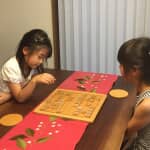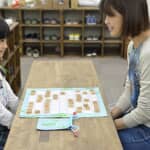24 January 2019
Even Preschool Children Can Have Fun at Learning Shogi! 6 Ways to Incorporate Game Elements into Lessons for Shogi Beginners
In a previous article, we told that it is effective to incorporate game elements into teaching Shogi in order for preschool children to concentrate on lessons without getting board. Even though you agree with us, some of you might think, “What should we do to do so?”
This time, I would like to introduce in detail the way I incorporate game elements into my Shogi classes.
1. Game to Collect the Same Piece
It’s quite natural that preschool children can’t read all Knaji or all Hiragana. In order for them to remember how to move Shogi pieces, first, they have to recognize the character of each piece as a design or shape. With the aim to help children get used to pieces’ characters I have introduced a game which requires children to collect the same pieces.
The rule of the game is the following:
First, teachers or parents set all pieces on a table, facing them up. Then children will find pieces that share the same character and group them. The important thing here is that you need to get interests from children when the game starts. I usually start this game with calling out,”Ready? Start!”
In the beginning, adults may participate in the game to support children by arranging pieces’ locations to make them easier to be grouped. By doing so, children can learn all of eight kinds of Shogi pieces. Once children finish grouping them, let’s say “Done!”, being happy together.
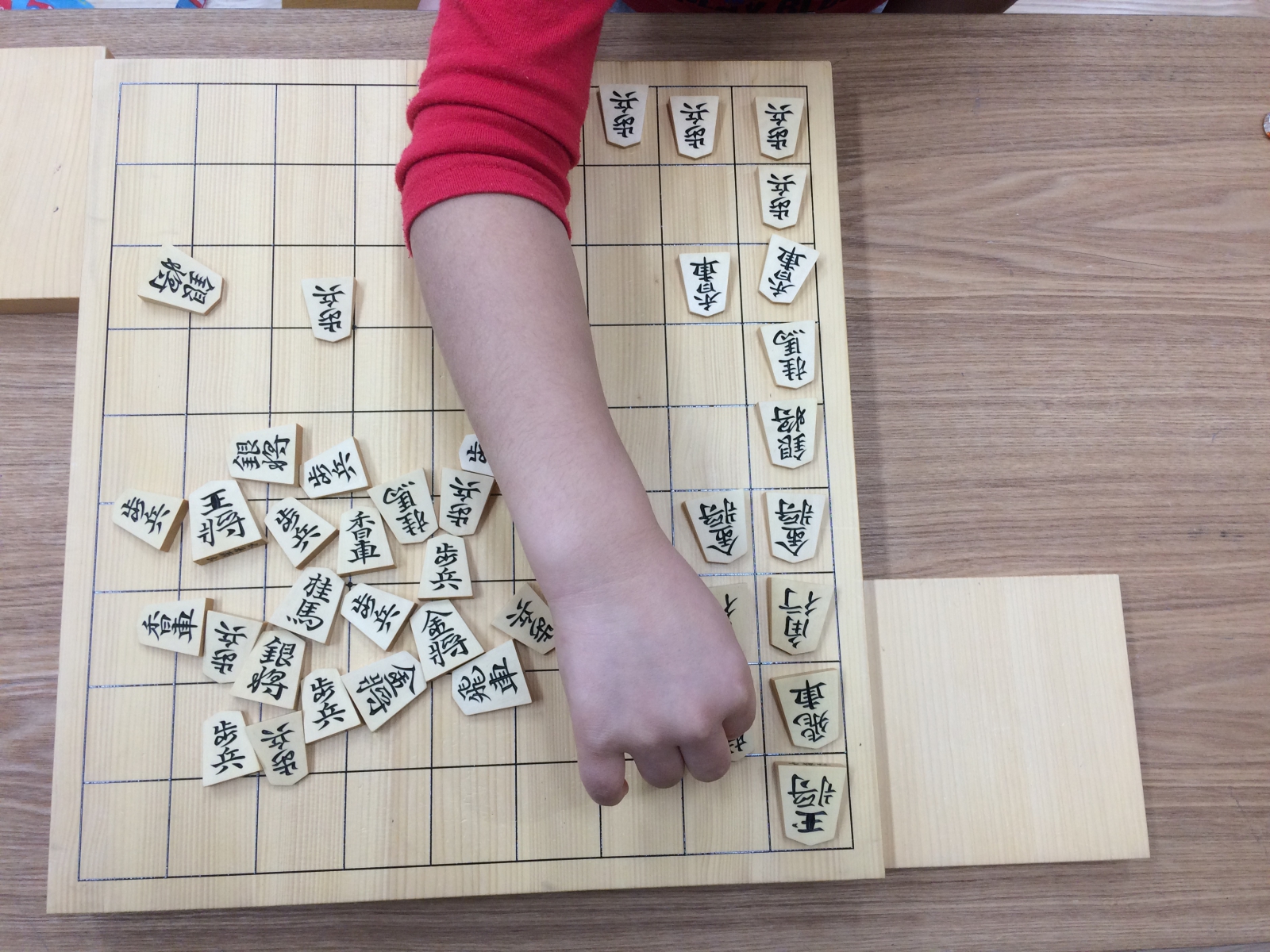
2. Domino: Joy of making
After preschool children get to be able to divide all pieces into eight groups, I will teach them that Shogi pieces have big ones and small ones. The key point at the beginning is to make things just fun for children. I try to provide opportunities as a break in which children enjoy Domino with Shogi pieces. Preschool children love this game!
When children set pieces on a board, I say, “If you set big pieces first, your Domino might be easy to fall down”. Working together to set pieces from the biggest Gyoku (King) to the smallest Fu (Pawn), I get children to be aware of the difference in size which each piece has. The greatest joy of Domino is, as you know, that you feel fulfilled when all pieces completely fall down at last. You may say aloud, “We did it!”
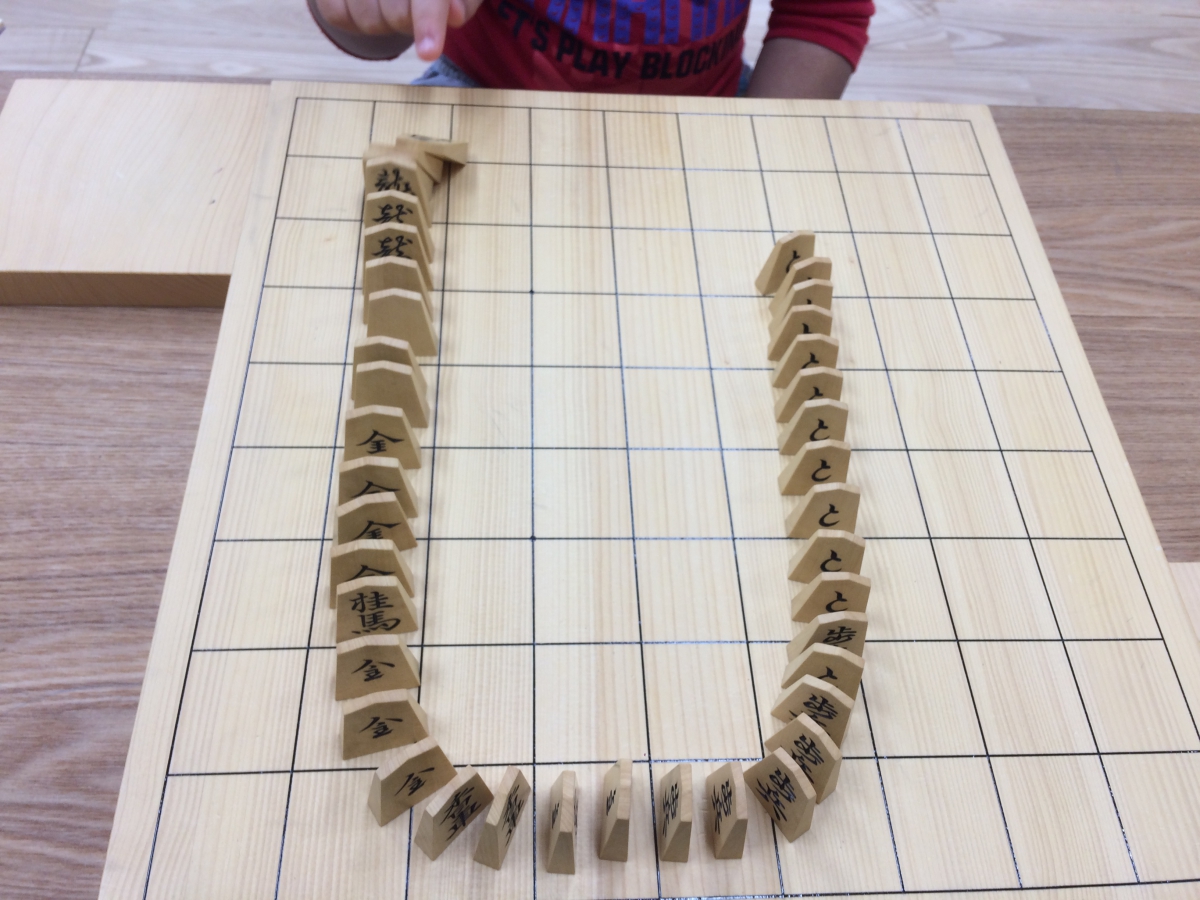
3. Yama-Kuzushi Game: To Memorize the Piece Names
Yama-kuzushi is a game which is often used before you start to learn actual Shogi games. I actively use this game during my classes for students to memorize pieces. Take one piece silently out of a pile of pieces. Then, I will ask some questions regarding the taken piece, such as “how to read it”, “how to move it” and so on. I use our special plastic board to confirm their knowledge. “This is Fu (Pawn). Let’s say “Fu“. Repeat after me!” I think it’s effective for preschool children to memorize things with reading out.
The more they play this game, the more they remember pieces. Then you might want to change the way to ask your questions. “What is this?” “….” If children can’t find the answer, you may give them a tip.
The real purpose of using this game is not to take pieces silently, but to memorize piece names. After getting the hang of playing Shogi, this game is useful to understand piece values. When it comes to an original strict rule, if you make hitting sound, “Click!”, the next player will take turns. I think it’s okay not to follow a such strict rule, when children and adults play together in Shogi classes or in the house.
As children lose their concentrations, they start to take several pieces at the same time. They often try to take 4 pieces or so at one time. That’s just fine. Rather it is more efficient to take some of them and confirm the knowledge about them at a time. Don’t you think so?
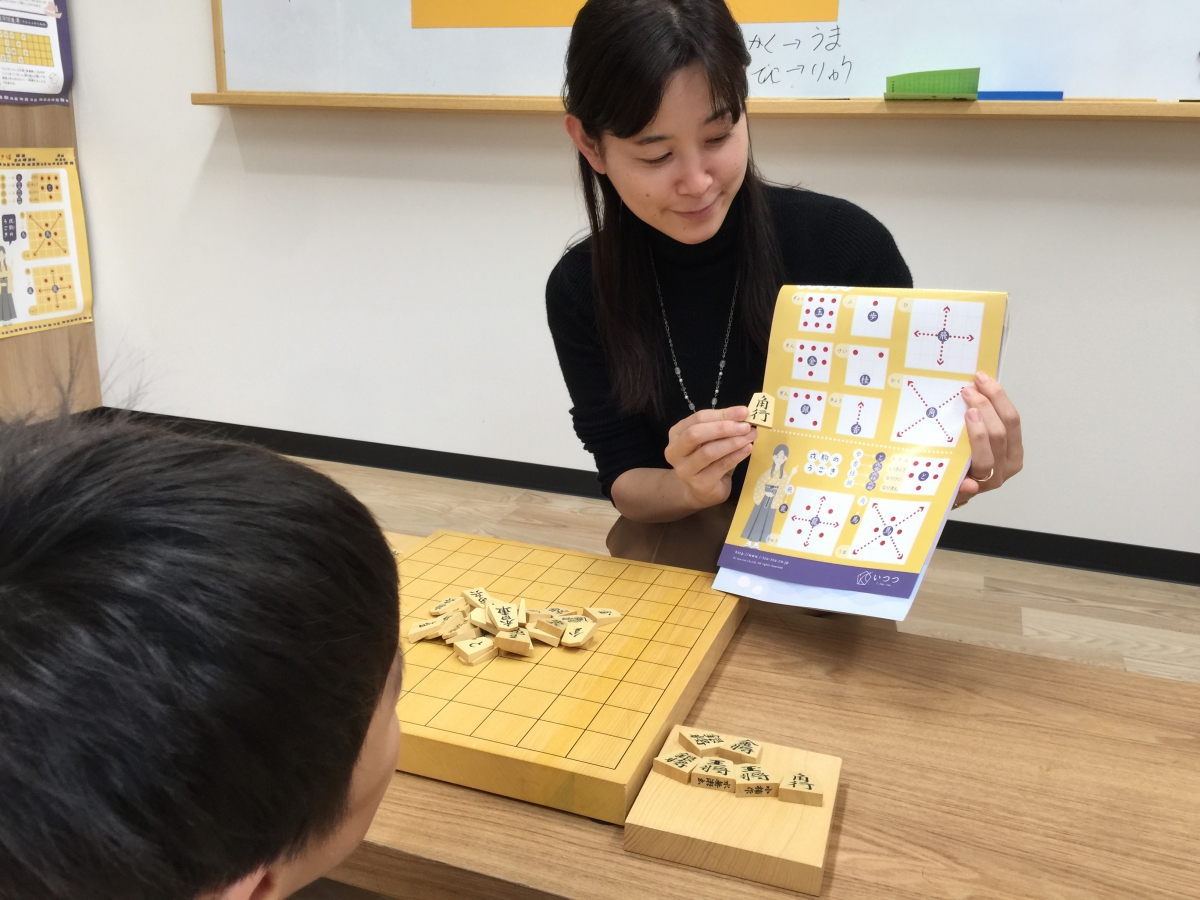
4. Ready?…Go!: Ohajiki (Marbles) Helps Children Understand Piece Moves Visually
The way to move pieces is one of big hurdles for preschool children who have just started Shogi. To help them understand how to move pieces, it works to compare piece moves to other things. For example, you may say, “The shape of Kin’s (Gold’s) moves looks like a mushroom”. Adding to that, we often have time to play a game with Ohajiki (marbles) during our i-tsu-tsu Shogi classes. The game is named, “Ohajiki Yoi-Don (Ready? start!)”.
The rule of this game is that you put marbles on a Shogi board, displaying each piece’s moves. Putting marbles on the path of moves, you can visualize it. Saying “Yoi-Don (Ready? Start!)”, children realize that they need to compete and get motivated. At the first, teachers or parents would help children put marbles. However, as they do this game several times, let children do by themselves. It’s good idea to decrease gradually the number of marbles that adults would put.
The order to put marbles could be the same order of Hisha (Rook), Kaku (Bishop), Kin (Gold), Gin (Silver), Kei (Knight), Kyo (Lance) and Fu (Pawn). While children do that, they’ll learn pieces’ moves little by little.
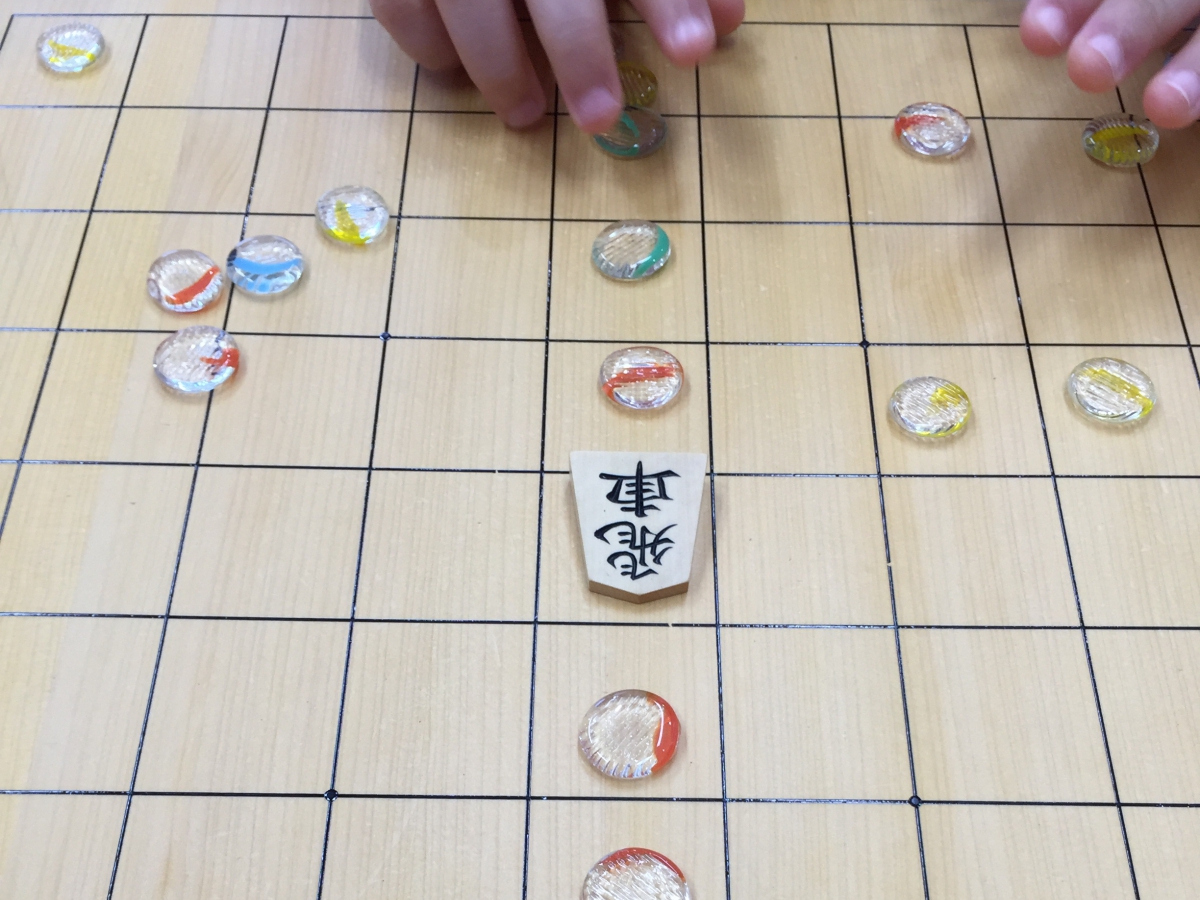
5. A Practice of Making To-Kin (Promoted Pawn) Is Like Fielding Practices in Baseball
One of techniques that are indispensable to play Shogi is “Promotion”. When you remember the type of Shogi pieces and how to move them, then start to practice how to promote pieces on a board.
The following method is that Mr. Odagiri who is a director of “Kiyukan” taught me. The method is called “Fu Nari Senbon Noku ” in Japanese. Senbon Noku, which is a figurative phrase, means a thousand ball drill. First, you line up pieces of Fu (Pawn) on the 4th rank, measuring time, repeat moving those Fu (Pawn) pieces to the 3rd rank and turning them up. In my case, I will do this by mixing other pieces such as Gin (Silver), Kei (Knight), or Kyo (Lance). Children might say, “Fu (Pawn) gets promoted, again Fu (Pawn) gets promoted,…Ah, this is Kei (Knight), so the move is different from Fu (Pawn). Kei (Knight) is going to be promoted like this!”. While moving pieces, children seem to have come to clearly remember how to move pieces. During real games, surely you don’t need to promote pieces hastily, but by measuring time children can be motivated more. If you do not have a chess clock, you can measure it with a stopwatch.
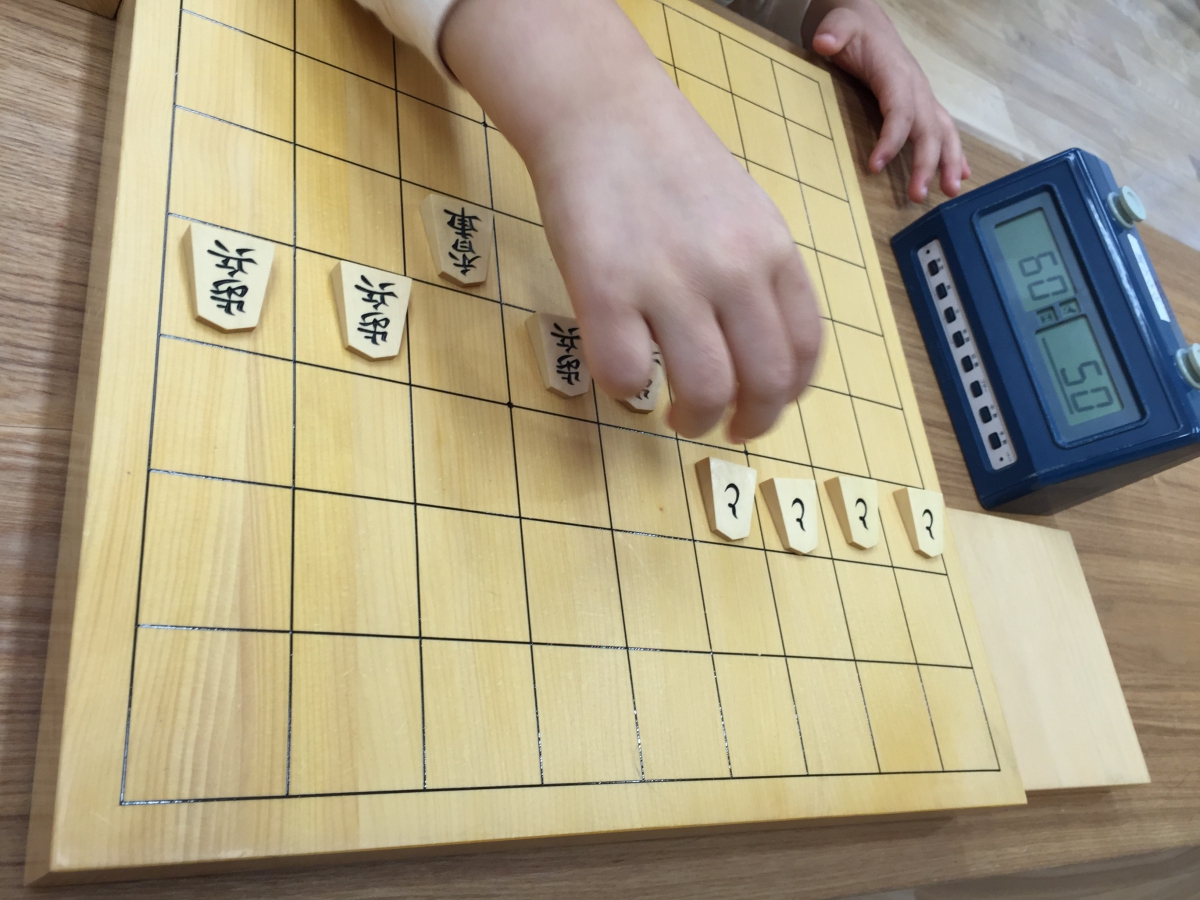
6. Capture Pieces in ZigZags
There is another important technique in Shogi, which is “Capturing”.
If your opponent’s piece is on the square which you can move your pieces to, it’s possible for you to capture the piece. Even preschool children can understand that logic. The problem here is how to capture the piece.
It is often observed during Shogi events that a player moves a piece and puts it on an opponent’s piece, and he/she captures the piece with his/her other hand. Or, a player pushes away an opponent’s piece to move a piece to there, and then puts the pushed piece on a piece board. At beginning, those behaviors could be acceptable, but in the future you should learn the following formal way to capture pieces:
1. Capture the opponent’s piece that you aim at and put it on a piece board.
2. Then move your piece.
These are very simple actions. However, if preschool children don’t have opportunities to lean them, they might find an action of “capture” difficult. We, i-tsu-tsu, provide the situation shown in the below picture, setting pieces on a board to practice capturing pieces. Gyoku (King) is set close to the opponent’s pieces, so that you won’t misjudge the abilities of pieces. Again, I think it’s good idea to measure time with a stopwatch, like other games.
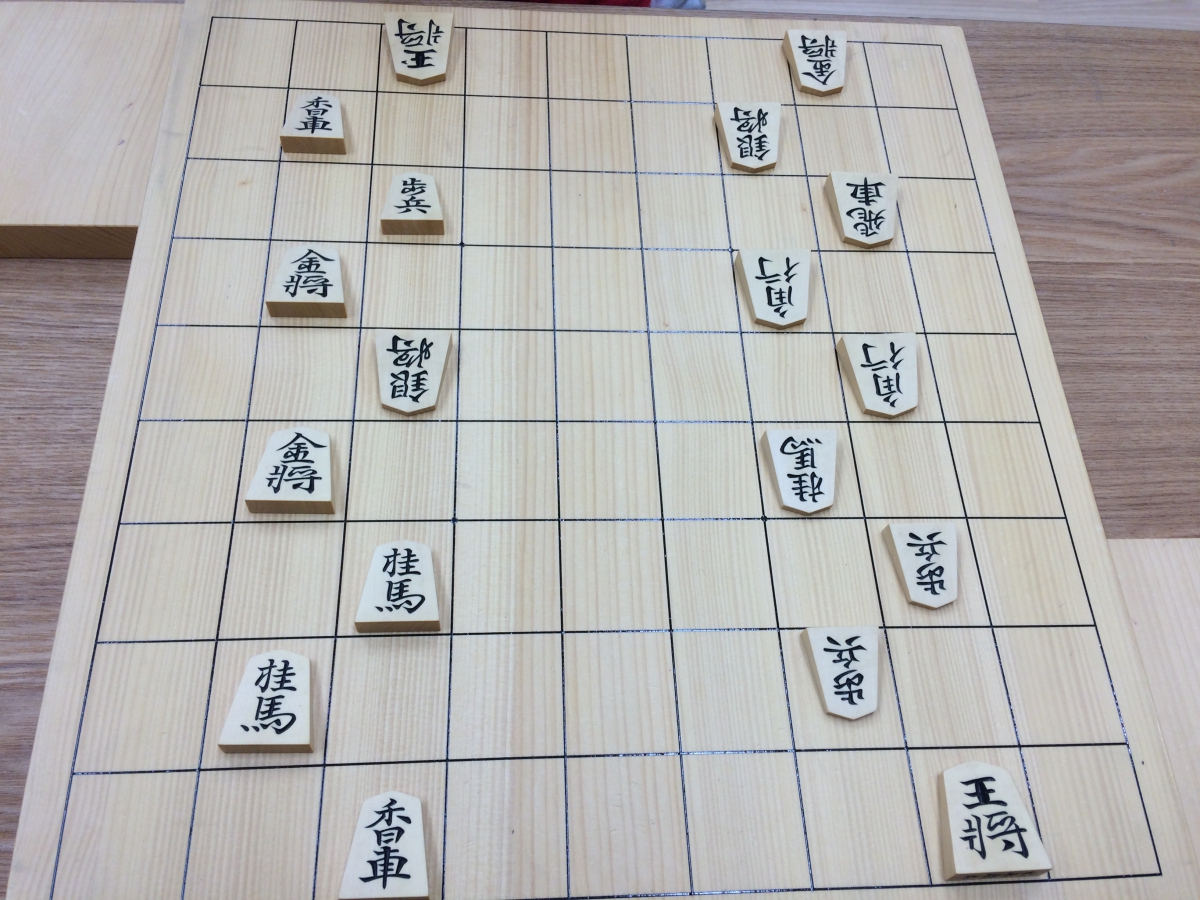
Well, this time I wrote about how to incorporate games into lessons to teach the basic principles of Shogi to preschool children.
In our Shogi lessons with preschool children, because children tend to keep their concentration at the beginning, we work on study style materials or difficult things (eg. our “Shogi Lesson Book for Beginners”). Then, when we notice that children start to lose their concentration, we have a break to play games.
I think preschool children are likely to prefer doing the same thing repeatedly. For example, when they play Domino, they seem to pursue something in the same game, saying “Okay, next time I will make three lines Domino. Then,…” You might want to provide a different game, each time they finish one game. I would recommend separating each games clearly with your attempts, such as saying “Ready? Start!” or bowing to start a game with greetings, “Onegaishimasu“.
Children may not fully understand things when they learn them as manual tasks. Preschool children are generally very honest. They show bored expressions when they feel bored. When they lose their interests in the lesson materials, they do different things. As teachers, it’s important to stock interesting materials as much as possible. If one material doesn’t work for children, you need to provide another. To accomplish your lesson’s goal, if you ignore children’s conditions and follow only your schedule, children may not listen to you. Let’s stop wasting time!
I would recommend observing children’s conditions very carefully, “How they are doing?”, “Do we need time for games?”, and so on.
At last, the most important thing is that teachers and parents should enjoy games with children. If teachers enjoy teaching, it definitely appeals children.

